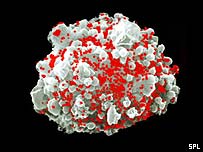I will be posting more about the Ohio Election in a bit (working on a scorecard or sorts see how many winners I picked), but before that I feel that there are several other great news items that I do not want to slip through the cracks.
First up
There has been a very interesting breakthrough in AIDS treatment that looks like it could lead to some promising treatments for drug resistant strains of the disease.

from here
The vehicle, or “vector,” that the researchers used to deliver the protective gene to the cells was a genetically modified HIV virus – also a first.
The five patients, who were no longer responding to conventional HIV drugs, have had no serious side effects during two years of follow-up. Four showed signs that the therapy was working – very unusual in such a preliminary clinical trial.
and here
Gene therapy involves removing immune T-cells and in this case genetically modifying them for (Human Immunodeficiency Virus) HIV resistance. Typically, gene therapy involves growing more cells outside the body and then placing them back into the patient.
Instead of chemical or protein based HIV replication blockers, this approach is genetic and uses a disabled AIDS virus to carry an anti-HIV genetic payload. The modified AIDS virus is added to immune cells that have been removed from the patients’ blood by apheresis. The immune cells are then purified, genetically modified, and expanded by a process that the researchers developed. The modified immune cells are then returned to the patients’ body by simple intravenous infusion.
and the BBC
They were given a single infusion of their own immune system T cells that had been removed from their blood, purified and genetically modified to carry the manipulated version of HIV.
Each patient received around 10 billion T cells – between 2% and 10% of the total number in an average person.
The disabled HIV gene used by the researchers was modified to carry an antisense RNA molecule, which scrambles the process of reading genetic information and is designed to sabotage the process HIV uses to reproduce itself inside infected cells.
Viral loads of the patients remained stable or decreased during the nine month trial – and one subject showed a sustained dramatic decrease in viral load.
T-cell counts remained steady or increased in four of the five patients.
The researchers were able to detect the modified cells in patients for months, and in some cases years after the infusion.
However, they warn that the trial was very small, and said patients would be monitored for 15 years to assess long-term effects.
And in ECO News there have been some great developments.

first up a great plan to build a huge solar power production plant in Australia. Don’t know why this has not happened sooner (could it be that the right wingers in Australia’s government are as tied to the oil as ours are?)
from here
In the face of overwhelming scientific evidence, the Australian Government has made a significant change in its energy policy by announcing it will contribute AUS$ 75 million [US$ 57 million] towards the building of the world’s largest solar energy plant as part of its recently unveiled renewable energy package.
“I think it’s an important shift [to support renewables] and a welcome shift. I think we are seeing from the federal Government for the first time, a recognition that there is such a thing as global warming.”
— Victorian premier Steve Bracks
The 154 megawatt solar power station — to be built as a private/public partnership in the southern state of Victoria — is the first component of a total AUS$ 125 million [US$ 96.7 million] Government package to clean carbon emissions on two projects in Victoria.The Federal Government has hailed the allocation of public funds for the station as a major step forward in its support for alternative energy.
Also in the news a closed loop Ethanol plant
The first closed-loop system for distilling commercial quantities of ethanol using methane gas recaptured from cow manure is set to begin production next month in Mead, Nebraska. The plant’s technology will virtually eliminate the need for fossil fuels in the production of ethanol.
“It may surprise you to learn that the most promising solution to our nation’s energy crisis begins in the bowels of a waste trough, under the slotted concrete floor of a giant pen that holds 28,000 … beef cattle.”
— Vinod Khosla, Sun Microsystems, co-founder
The closed-loop system — derived from an exclusive patent co-owned by an affiliate of E3 BioFuels — combines a 25-million-gallon ethanol refinery, beef cattle feedlot and anaerobic digesters to maximize energy efficiencies unavailable to each component on a stand-alone basis.
This system eliminates the potential for manure to pollute watersheds, and it enables the wet distiller’s grain from ethanol production to be fed on-site to cattle without energy-intensive drying and transportation costs.
In the October edition of Wired Magazine, venture capitalist Vinod Khosla wrote, “It may surprise you to learn that the most promising solution to our nation’s energy crisis begins in the bowels of a waste trough, under the slotted concrete floor of a giant pen that holds 28,000 … beef cattle.”
And in ECO-Political news it seems voting Dem was not the only thing on peoples minds.
From here.
The future of solar — and renewable energy as a whole — just got a whole lot sunnier in the state of Arizona. By a vote of 4-1, the Arizona Corporation Commission (ACC) voted on October 31 to expand the state’s renewable portfolio standard to 15% by 2025, with 30% of that to come from distributed generation technologies — potentially resulting in up to 2,000 megawatts of solar.
“The state has no regulations for interconnection standards, nor net metering. The financial incentives are the engine for solar’s development — but these policies are the road… now is the time to celebrate.”
— Adam Browning, Vote Solar Initiative, director
The historic vote puts Arizona in the running to become the largest solar program in the country, right behind California and potentially ahead of New Jersey.
“With world-class sunshine and explosive population growth, Arizona is well positioned to become a key solar market. The game’s not over yet, however. It takes more than incentives to make a sustainable solar market. The state has no regulations for interconnection standards, nor net metering. The financial incentives are the engine for solar’s development — but these policies are the road… now is the time to celebrate,” stated Adam Browning, director of the Vote Solar Initiative, in an e-mail announcing the results of the October 31 vote.
Funding for the Renewable Energy Standard will be provided through a tariff assessment of $0.004988 per kilowatt-hour (kWh) with monthly impacts capped at $1.05 for residential customers, $39 for small commercial, and $117 for large commercial. The new standard also allow for new and emerging technologies to be added as they become feasible.
The ACC’s vote yesterday marked the end of a two-year campaign to revise and expand Arizona’s existing Environmental Portfolio Standard, which required just 1.1 percent of electricity sold in the state to come from renewables.
Over all things are looking good, ohh ps. RUMSFIELD JUST RESIGNED!